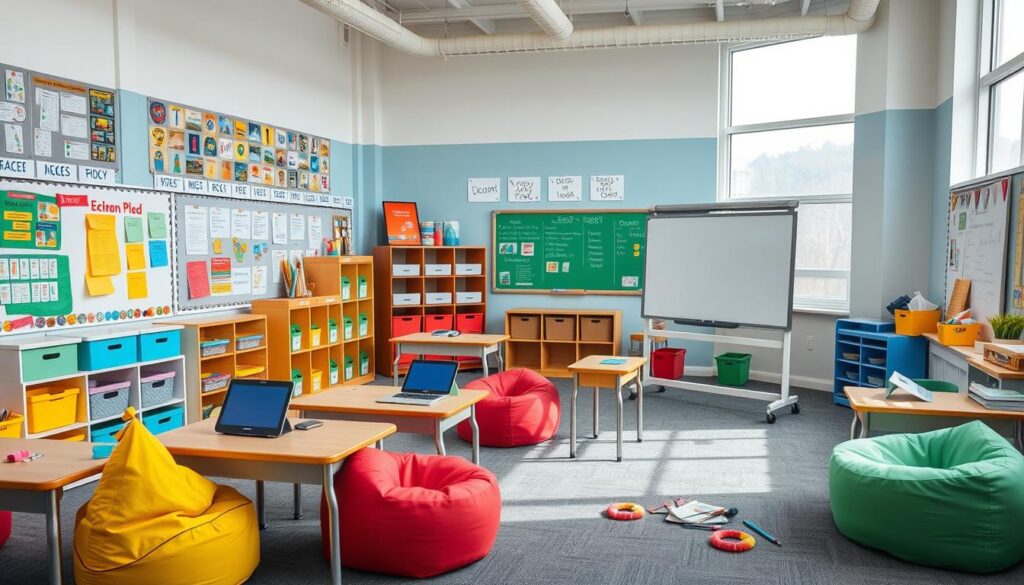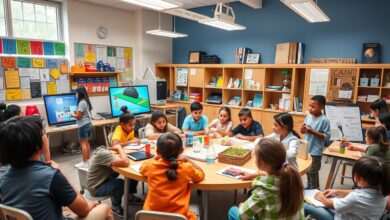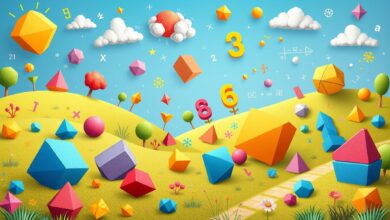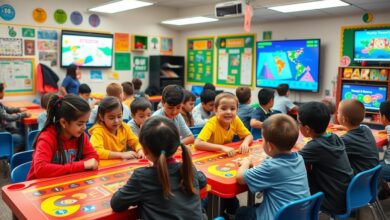Classroom Routines: Boost Student Success & Learning Environment

Table of Contents
As an educator, setting up effective class routines is essential. These routines make the class run smoothly and help students feel safe and successful. By using good classroom management strategies, you help your students perform at their best.
Creating Classroom Routines
A lively classroom scene with a diverse group of students engaging in various organized activities, colorful bulletin boards displaying daily schedules, neatly organized desks, a prominently displayed calendar, sunlight streaming through large windows, and learning materials such as books and art supplies systematically arranged throughout the room.
Understanding the Importance of Classroom Management

Effective classroom management is key to student success. Teachers use structured routines and strategies to create an optimal learning environment. This section reviews how classroom management boosts student achievement and the benefits of consistent routines.
Impact on Student Learning and Achievement
Classroom management is crucial for student learning and success. When classes are organized, students can focus more on learning. This leads to better academic results.
Benefits of Well-Structured Routines
Consistent classroom routines have many benefits. They make students feel secure and help them manage their time better. This leads to better focus and greater engagement in learning.
Creating a Positive Learning Environment
Good classroom management helps create a positive learning space. Teachers set clear rules and use positive reinforcement. This makes students feel valued and motivated to learn.
“Classroom management is not about discipline. It’s about preventing discipline problems by creating an environment conducive to learning and personal growth.”
How to Create Lasting Classroom Routines
Establishing lasting classroom routines is key to teaching success. To make these routines stick, introduce them carefully and reinforce them throughout the year.
- Start by clearly communicating the daily schedule and class rules.
- Let students help create these routines. This makes them feel more involved and responsible.
- Introduce new routines slowly. Changing too much at once can confuse and overwhelm students.
- Use visual aids like class schedules and checklists to help students remember routines.
- Always reinforce good behavior with praise and rewards when students follow rules.
- As the year progresses, be ready to adjust and refine routines as needed. Watch how they work, ask students for their input, and tweak them to keep them effective.
“Consistency is key to creating lasting classroom routines that support student learning and create a positive, productive learning environment.”
By using these methods, you can build classroom routines that endure. These routines will help make your class an organized and successful place to learn.
Routines
| Routine | Purpose | Strategies for Success |
|---|---|---|
| Daily Schedule | Provide predictable structure and set expectations for the day | Visually display the daily schedule. Refer to the schedule throughout the day. Involve students in schedule creation. |
| Arrival Procedures | Ensure a smooth and orderly start to the day | Establish clear procedures for entering the classroom. Assign specific tasks or responsibilities to students. Offer a morning greeting and welcome. |
| Transition Times | Minimize disruptions and maintain momentum during lessons | Use timers or signals to indicate time for activity changes. Provide clear instructions for transitioning between tasks. Praise students for smooth transitions. |
By following these strategies, you can establish classroom routines that will endure and contribute to an organized and successful learning experience for both teacher and students.
Creating Effective Morning Routines for Students

Starting the day right is essential for a productive classroom. Teachers can make mornings great by having clear arrival plans, engaging morning meetings, and setting clear goals. This helps create a positive and focused learning environment from the start.
Arrival Procedures
A good morning welcome needs a solid plan. Set up areas for bags and coats and morning check-ins. Greet each student warmly and guide them through the morning routine. This helps them start their school day smoothly.
Morning Meeting Strategies
- Start with a quick whole-class meeting to build community and excitement for the new day.
- Use fun activities like icebreakers or team-building exercises to engage students and make them feel part of the group.
- Share the day’s goals, expectations, and any important news during this time.
Setting Daily Expectations
Being clear about what’s expected helps students take responsibility for their learning. Set a visual schedule, review class rules, and talk about the day’s goals. This way, you can minimize distractions and maximize learning time.
Morning Routine Component
| Morning Routine Component | Key Strategies |
|---|---|
| Arrival Procedures | Designated areas, warm greetings, established routines |
| Morning Meetings | Community building, schedule review, expectation setting |
| Communicating Expectations | Visual schedules, procedure review, goal discussion |
By carefully planning and implementing these morning routines and class procedures, teachers set a strong foundation for a successful school day. This empowers students to perform at their best.
Implementing Successful Transition Strategies
Smooth transitions between activities are crucial for a productive classroom. Good transition activities and classroom management strategies help minimize disruptions. This allows students to stay focused and on track.
Transition Strategies
- Assign clear signals for starting or ending activities.
- Use timers or countdowns to help with time management.
- Encourage students to work together to organize transitions easily.
By implementing these strategies, teachers can ensure smooth transitions that keep the classroom running efficiently.
Fostering Positive Student Behavior

Positive reinforcement is an effective strategy that helps motivate students to adhere to classroom routines. By praising good behavior, students feel valued, which enhances their desire to actively participate in learning activities.
The Importance of Positive Reinforcement
Using positive reinforcement enhances student behavior and encourages them to continue following rules and routines. When students feel their efforts are noticed, it motivates them to work harder.
Positive Reinforcement Strategies
- Use specific and realistic praise when tasks are completed or rules are followed.
- Give students small rewards like stickers or points when they demonstrate positive behavior.
- Organize small appreciation parties, such as “student of the week” to increase motivation.
Examples of Positive Reinforcement
| Reward | Strategy |
|---|---|
| Stickers or Points | Reward good student behavior on a daily or weekly basis. |
| “Student of the Week” | Recognize students who show positive behavior throughout the week. |
| Class Rewards | Reward the whole class when students adhere to class rules well. |
By implementing positive reinforcement strategies, teachers can improve classroom behavior and foster an active and positive learning environment.
Dealing with Classroom Behavior Challenges
Despite best efforts to create effective classroom routines, dealing with behavioral challenges is inevitable. It’s important for teachers to have strategies to address unwanted behaviors in a respectful and effective manner.
Strategies for Addressing Negative Behaviors
- Address unwanted behaviors immediately and redirect students to appropriate conduct.
- Use timeouts or positive redirection as a way to help students de-escalate their behavior.
- Create a long-term behavior guidance plan that includes ongoing communication with parents and counselors if necessary.
Techniques for Calming Students
Sometimes, students might struggle to stay calm. With a few simple techniques, such as deep breathing or relaxation exercises, students can self-soothe and quickly regain focus.
Examples of Calming Techniques
| Technique | Description |
|---|---|
| Deep Breathing | Teach students how to breathe slowly and deeply to calm themselves. |
| Relaxation Exercises | Give students small tasks that involve stretching or relaxation to improve their focus. |
By implementing these techniques, teachers can address behavioral challenges and improve the classroom environment.
Building Effective Communication Systems
Building strong communication systems in the classroom is fundamental to good classroom management strategies and creating a positive learning environment. Focus on three main areas: teacher-student communication, student-to-student interactions, and collaboration with parents. This helps foster a supportive community within the classroom, which helps students succeed.
Teacher-Student Communication
Good communication between teachers and students is the foundation of an organized classroom. Set aside time for one-on-one conversations to give feedback, solve problems, and build rapport with students. Use various communication methods like notes, emails, or direct talks to ensure students feel valued.
Student-to-Student Interactions
It’s important to help students interact well with each other. Provide opportunities for group work, class activities, and peer feedback. By using positive reinforcement, you help students learn important social and communication skills.
Teacher-Parent Collaboration
Involving parents in their child’s learning is a great way to boost student success. Set up ways to communicate like newsletters, meetings, or online tools. This way, families and teachers can work together to support each student’s needs. When everyone works together, greater student success happens.
By creating these communication systems, you can foster a learning environment where everyone feels connected. This leads to increased student engagement and sets them up for success in school and life.
Integrating Positive Reinforcement Techniques
Effective classroom management is not just about rules; it’s also about using positive reinforcement to create a supportive learning environment. This approach encourages good behavior and helps students succeed. Positive reinforcement works to increase student engagement and performance.
Recognizing and rewarding student efforts is a big part of positive reinforcement. This can be done in various ways, such as:
- Verbal Praise: Acknowledging students’ hard work, progress, or positive actions by giving honest and specific feedback.
- Tangible Rewards: Offering small prizes, stickers, or other incentives to reinforce desired behaviors.
- Privilege-Based Rewards: Providing students with opportunities to earn extra free time, choose their seating arrangement, or participate in a special activity.
Consistency is crucial when using positive reinforcement. You need to set up a clear system for rewarding students when they meet your expectations. This consistency strengthens good behavior and motivates students to keep trying.
Positive reinforcement is not just about giving rewards; it’s also about making students feel valued and supported. By using these strategies, you can make your classroom a place where students can thrive and achieve success.
“Effective classroom management is not about controlling students, but about creating an environment where learning can flourish.”
Managing End-of-Day Procedures
Smooth end-of-day procedures are essential for a calm end to the school day. By creating organized routines, you can ensure students leave in an orderly fashion. This helps them start their home day right.
Packing Up Routines
Make sure students know how to pack their belongings. Use designated areas for gathering things and a countdown system to signal the end of the day. A checklist helps ensure they don’t forget anything.
Dismissal Strategies
Plan how students will leave the classroom. Use staggered times and clear pathways to avoid congestion. Technology, like signage or apps, can also help you make things run smoothly.
Final Check-Out Procedures
Do a quick check to ensure everyone has left the room and the room is tidy. Make sure windows are closed, lights are off, and everything is secured. Review the day’s events and plan for the next day.
By following these routines and classroom procedures, you can ensure a smooth end to the school day. This helps set students up for success, both in school and beyond.
Classroom Routine
Setting up a vibrant classroom during end-of-day procedures, where students are shown lining up orderly at the door, school bags neatly placed beside their desks, with a smiling teacher leading them, and colorful routine charts on the walls, sunlight streaming through large windows, with a clock showing time nearing the end of the day, and various school supplies neatly arranged.
End-of-Day Procedures
| Best Practices | Packing Up Procedures | Dismissal Strategies | Final Check-Out Procedures |
|---|---|---|---|
| Designated areas for gathering belongings | Countdown system to signal end of day | Ensure all students have left | |
| Countdown system to signal end of day | Staggered dismissal methods | Ensure windows are closed and lights are off | |
| Checklist to ensure students don’t forget anything | Monitoring system to prevent congestion | Review day’s events and plan for next day |
“Effective end-of-day procedures are the foundation of an organized classroom management. By creating clear routines and strategies, you can create a smooth transition from school to home, which helps students succeed.”
Conclusion
Creating effective classroom routines is key to establishing a productive learning environment. We’ve discussed why classroom management is important and how it promotes student success. We also covered how to build a positive classroom atmosphere.
By following the steps in this guide, you can set up routines that help students stay organized and engaged. This includes morning routines, transitions, clear expectations, and positive reinforcement. These strategies can significantly improve student learning and personal growth.
It’s important to keep working on your classroom routines to ensure they last. If you stay committed to this effort, you’ll see how routines can transform your classroom for the better. By using these strategies, you can help students reach their full potential.
FAQ
How can I create effective classroom routines?
- Clearly explain what you expect from students.
- Start new routines slowly and keep practicing them.
- Use pictures or lists to help students remember.
- Let students help set up routines to encourage participation.
- Review and adjust routines as needed throughout the school year.
What are the benefits of organized school routines?
- Improved time management and increased instructional time.
- Helps students stay focused and behave better.
- Reduces problems and disruptions.
- Creates a more organized and effective learning environment.
- Teaches students how to be more independent and responsible.
- Enhances collaboration between teacher and students.



